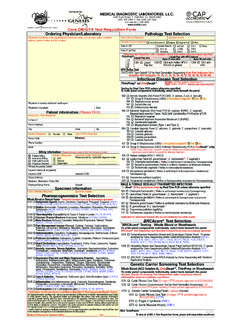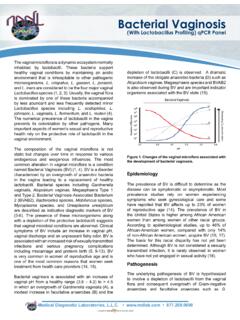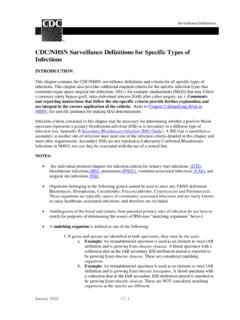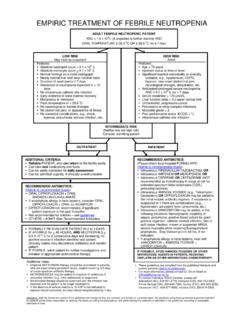Transcription of Medical Diagnostic Laboratories, L.L.C.
1 Medical Diagnostic laboratories , Guide for Available TestsUpd - 3/2016 Table of ContentsMedical Diagnostic laboratories , Kuser Road Hamilton, NJ Toll Free 877 269 0090 Specimen -7 Gynecology/Urology ..8-35 Genetic Carrier Screening ..46-57 Intestinal Pathogens ..58-61 Mycology ..62-66 Respiratory Pathogens ..67-76 Skin & Soft Tissue Infections (SSTI)..77-79 Vector-Borne Pathogens ..80-85 Virology ..86-98 Genetic Testing .. Specimen GuidelinesProper collection, processing, and transport of specimens are vital to ensure specimen integrity for laboratory testing. Specific specimen requirements are listed under each test in the Test Listing sections. To avoid delays in testing/diagnosis and to prevent potential specimen rejection, be sure to follow these requirements when collecting a particular specimen. Upon receipt of a specimen, the condition of each sample will be assessed by laboratory personnel using specific guidelines to identify improper or inadequate specimens that offer the possibility of inaccurate results.
2 Any sample that does not meet the acceptance criteria will be deemed suboptimal. All suboptimal specimens shall be evaluated by the Department of Quality Assurance & Quality Control. Acceptance Criteria: Requested test is performed in this Laboratory. Sample is received in good condition and in the appropriate collection/transport vessel. Patient identifiers on sample match patient identifiers on the requisition. Sample is received at the proper temperature after transport. Sample is labeled with at least two patient identifiers. Sample is of sufficient volume. There is sufficient DNA following the extraction process for the test(s) to be performed. Samples that meet the acceptance criteria, but are deemed to be suboptimal, may continue to be processed. As suboptimal sample conditions may impact test performance, a report will be sent to the referring health care provider detailing the suboptimal specimen condition(s).
3 In the event that corrective action is possible, the referring health care provider may be contacted by our Specimen Resolution Center (SRC) for additional information or Specimen Conditions: Tests requested are not appropriate for the specimen type received. Sample is received in an inappropriate collection/transport vessel. Blood is hemolyzed or lipemic depending on the particular test(s) ordered. Specimen is not received at the proper temperature. Sample is not labeled with at least two patient identifiers. Sample is of insufficient repeat sample will only be requested in instances whereby the suboptimal specimen condition will negatively impact testing. Rejected specimens will not be processed further. A report will be generated to notify the referring health care provider of the reasons for the specimen rejection and a new sample may be requested, if appropriate. Please note, in the instance of irretrievable specimens, where recollection is NOT an option, the suboptimal criteria will be brought to the attention of the Director of Quality Control and will be reviewed on a case-by-case basis.
4 Specimen Labeling:The College of American Pathologists (CAP) guidelines state that all primary clinical specimen containers should be labeled with two patient identifiers at the time of specimen collection. These identifiers must correspond to information provided on the test requisition form or accompanying documents. We will note on the result report when a specimen was received without the required two patient first identifier Patient s first & last namePreferred second identifier Patient date of birthOther acceptable identifiers Social security numberRequisition numberPatient identification numberMedical record numberAccession numberUnique random numberAdditional desirable information Date of collectionTime of collectionSpecimen typeSpecimen Toll Free: Requirements Biopsy (fresh)Collection vessel:Sterile non-additive container with PBS buffer or sterile normal physiological saline :Minimum size requirement is 1mm X 1mm Conditions: Refrigerate.
5 Ship with a cold Notes: Please list specimen source on the container and test requisition form. Do not use the yellow top (ACD solution A) blood collection (paraffin block)Collection vessel:Sterile non-additive containerVolume:Shave 5-7 sections of a paraffin block and place in a sterile container. Transport Conditions: Stable at room Notes: Please list specimen source on the container and test requisition form. Do not use the yellow top (ACD solution A) blood collection Fluid (CSF)Collection vessel:Sterile non-additive :Minimum 1mlTransport Conditions: Refrigerate. Ship with a cold Notes: Please list specimen source on the container and test requisition form. Do not use the yellow top (ACD solution A) blood collection vessel:Sterile non-additive :N/ATransport Conditions: Stable at room Notes: Be sure that you did not eat, drink, chew gum or smoke for at least 1 hour prior to sample collection.
6 Ensure that you do not have an allergy to mint-containing solutions. Sample collection must be performed in the presence of a healthcare Toll Free: Collection vessel:CompleteVolume:N/ATransport Conditions: Stable at room Collection vessel:CompleteVolume:N/ATransport Conditions: Stable at room vessel: Serum separator tube (SST) Red/gray or tiger top tube containing clot activator and gel for serum :Complete is preferred. Minimum volume is Conditions: Refrigerate. Stable for 48 hours after collection. After 48 hours, specimen must be Notes: Immediately after blood collection, invert the tube(s) gently 5 times to ensure mixing of clot activator with blood. Allow the tube to rest in an upright position for at least 30 minutes but not longer than 1 hour after collection to ensure proper clotting. Centrifuge for at least 15 minutes at 2200-2500 RPM within one hour of collection.
7 Do not remove the stopper or pour off serum. Synovial Fluid Collection vessel:Sterile non-additive :Minimum 1mlTransport Conditions: Refrigerate. Ship with a cold Notes: Please list specimen source on the container and test requisition form. Do not use the yellow top (ACD solution A) blood collection Toll Free: Collection vessel:CompleteVolume:N/ATransport Conditions: Stable at room vessel:Clean non-additive container or zip-lock :N/ATransport Conditions: Stable at room Notes: Ticks can be submitted alive or dead. Do not place in alcohol, burn, or place on tape. Ticks are consumed during the extraction process and therefore cannot be returned after testing. Turnaround time for tick testing is typically 3-5 days but may Collection vessel:CompleteVolume:N/ATransport Conditions: Stable at room BloodCollection vessel:Yellow top tube (ACD solution A) Volume:CompleteTransport Conditions: Stable at room temperature for 48 hours after Notes: Completely fill the tube whenever possible to eliminate dilution from the anticoagulant and ensure the proper blood-to-anticoagulant ratio.
8 Immediately after blood collection, invert the tube(s) gently 8-10 times to ensure mixing of anticoagulant with blood to prevent clotting. Do not shake tube(s). Do not centrifuge Toll Free: / Urology369 Acinetobacter baumannii by Real-Time PCRC linical significance: Acinetobacter baumannii is an aerobic, Gram-negative bacterium that is resistant to most antibiotic treatments and is responsible for many hospital patient deaths, the first case being linked directly to wounded soldiers returning from the Iraq war. An emerging, opportunistic, multi-drug resistant bacterium, Acinetobacter baumannii infection cases are expected to rise and have the potential to become the next superbug with a magnitude and scope similar to that of MRSA. A. baumannii is associated with long term wound, skin and soft tissue infections, catheter-associated UTIs, ventilator associated infections, bloodstream infections, surgical site infections, and co-infections with other bacteria, such as MRSA, is common.
9 Those with compromised immunity are at greatest risk of infection. A few studies have looked for A. baumannii as well as MRSA colonization of anterior nares, skin, sputum, perianal, wounds, etc. This can be an environmental contaminant of hospitals and long-term care facilities. Colonization of healthy individuals occurs in an asymptomatic fashion but poses an increased risk of dissemination throughout hospital wards. Method: Real-Time PCR Specimen: UroSwab (males & females), NasoSwab , whole blood yellow top tube (ACD solution A) Transport: Stable at room temperature Turnaround Time: 24-48 hours150 Actinomyces europaeus by Real-Time PCRC linical significance: Although Actinomyces species can be found as normal flora of the mouth, they are also considered opportunistic pathogens in infections associated with human bite wounds, abscesses, infections of the eye and mouth, as well as the gastrointestinal, genital, and urinary tracts.
10 A. europaeus has been associated with cystitis and is often recovered from abscesses of various body sites. In this assay, DNA is extracted from the specimen and subjected to PCR amplification. Method: Real-Time PCR Specimen: OneSwab , UroSwab (males) Transport: Stable at room temperature Turnaround Time: 24-48 hours143 Actinomyces israelii by Real-Time PCRC linical significance: Actinomyces israelii is a filamentous, anaerobic, Gram-positive bacterium. The infection begins as an inflammatory soft tissue mass, which can enlarge into an abscess-like swelling. All species of Actinomyces are normal commensal inhabitants of the oral and buccal cavities in humans. The anaerobic actinomycetes are not transmitted sexually and are not generally considered as part of the normal vaginal flora. Colonization in the female genital tract is stimulated greatly by the presence of a foreign body, such as intrauterine contraceptive devices (IUCDs), hairpins, and even surgical sutures.











